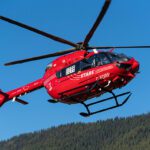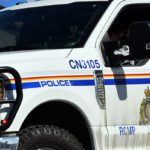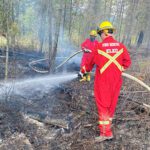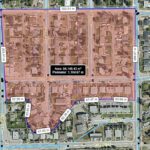Home »

Flathead border site location of multi-discipline camp

It is as large as the Columbia and Kootenay valleys, though not as lengthy.
It has been the epi-centre of several environmental issues, including mining, fracking and park creation/addition.
It is unbridled and unparalleled wilderness splendor that is halted by an invisible line.
It is the Flathead Valley south of Fernie/Sparwood.
A couple of weeks ago, the Flathead hosted a number of groups of people who experienced its natural wonders on different levels, but came together as one – parted by that invisible line – for one grand feast.

Almost 100 people gathered at the Canada-U.S. border in the Flathead River Valley for the ‘Flathead Feast’ on Monday, August 20 to celebrate the trans-boundary Flathead River Valley and call for its permanent protection.
The Flathead River has dual citizenship: beginning in southern British Columbia, it flows south across the U.S. border into Montana. Efforts to add the B.C. Flathead Valley to the adjacent Waterton-Glacier International Peace Park—a World Heritage Site and two UNESCO Biosphere Reserves – have been ongoing for decades.
The Flathead Feast was the culmination of 10 days of activities in the B.C. Flathead, including a Bioblitz with scientists from the Royal BC Museum, an artist retreat and workshop, and a celebration of a 2011 legislated ban on mining and energy

development in the B.C. Flathead.
People gathered on each side of the defunct border crossing, sharing conversations and food. While there were curries on one side and organic yak burgers on the other, everyone shared the sentiment that the Flathead is a special place that deserves permanent protection.

Wildsight and other conservation organizations are calling for a national park in the southeastern one-third of the B.C. Flathead, to fill in the missing piece of the Waterton-Glacier World Heritage Site.
They are also urging the B.C. government to agree to a Wildlife Management Area in the rest of the Flathead and adjoining habitat, to preserve a vital link in a wildlife corridor stretching from Glacier National Park to Canada’s Rocky Mountain parks.

For 10 days leading up to August 20, scientists and artists visited the Flathead, each documenting in their own way the biodiversity and beauty of the area.
Royal BC Museum scientists, Parks Canada and the American Bird Conservancy members participated in the Bioblitz, whose findings will be released later this year.

Artists from across the East Kootenay joined wildlife and landscape painter Dwayne Harty for workshops and ‘en plein air’ painting sessions, and will contribute to an upcoming art exhibition.
Conservation organizations working to protect the Flathead permanently are Wildsight, Sierra Club BC, the Canadian Parks and Wilderness Society, Headwaters Montana, the National Parks Conservation Association and the  Yellowstone to Yukon Conservation Initiative.
Yellowstone to Yukon Conservation Initiative.
Early reports note that the Bioblitz work may yield some exciting scientific findings.
“They won’t know their findings until they are back in the lab, but they know they found an endemic spider and ladybird beetle here in the Flathead,” said Wildsight’s Robyn Duncan, who helped stage the successful camp.
“The Bioblitz brought in eight biologists to do a rapid assessment of species in the Flathead. Six were biologists from the Royal BC Museum; all entomologists. It was fascinating to see the critters they discovered. A lot of work has been done studying the mega fauna, like grizzly bears, of the Flathead, but it was inspiring to see all of the tiny critters that call it home. One gentleman was from the American Bird Conservancy. One of the more exciting finds was trumpeter swans that had been re-introduced in the U.S. He had been part of the  reintroduction efforts and positively identified the market bands. It was a true testament to the trans-boundary ecosystem of the Flathead! The Bioblitz was so successful that we’ve already begun planning next years! It will be in June in order to document species in a different season,” Duncan outlined.
reintroduction efforts and positively identified the market bands. It was a true testament to the trans-boundary ecosystem of the Flathead! The Bioblitz was so successful that we’ve already begun planning next years! It will be in June in order to document species in a different season,” Duncan outlined.
The Artist Retreat/Workshop brought in eight artists from the Elk Valley, Columbia Valley and Cranbrook.
“Art is a powerful medium for communication. It was truly a pleasure to have Dwayne Harty join us in the Flathead to host both the retreat and the workshop. Dwayne’s works are currently featured in an exhibition at the Whyte Museum in Banff; ‘Yellowstone  to Yukon: The Journey of Wildlife and Art.’ It’s truly a remarkable collection that showcases this landscape through art,” Duncan said.
to Yukon: The Journey of Wildlife and Art.’ It’s truly a remarkable collection that showcases this landscape through art,” Duncan said.
Some of the artists painted plein air, while others sketched and took photos in preparation for their paintings.
“They will all, including Dwayne, be contributing artwork to an art exhibition that will begin touring in early 2013 to help raise awareness about the Flathead Valley. I was lucky to spend a whole day with Dwayne, watching him paint. He is renowned as a plein air painter. I watched as he magically transformed a blank canvas to a truly spectacular painting in mere hours! Mountains, moving water, trees, skies – it was incredible,” Duncan exclaimed.
 Five artists from the Elk Valley and Invermere took part in the three day retreat, while another eight artists, most from the Elk Valley, spent August 19 day learning plein air techniques from Harty.
Five artists from the Elk Valley and Invermere took part in the three day retreat, while another eight artists, most from the Elk Valley, spent August 19 day learning plein air techniques from Harty.
The next day featured a hike up Mount Hefty which offered fabulous views over the Flathead Valley. And that was rounded off with a transboundary feast, with 60 people on the Canadian side and 40 on the American side (pictured at top).

“The feast was a fabulous wrap-up for the activities and truly symbolic. People gathered on each side of the border, celebrating the trans-boundary nature of the Flathead River and the trans-boundary work to protect the watershed. The successes in the Flathead Wild campaign have made possible by people working together on both side of the border to protect the wild Flathead,” Duncan said.
“Events like the Bioblitz, feast, or Artist Retreat are a great way to connect people to the landscape. Many groups and individuals have been actively working to protect the Flathead River Valley for decades. Despite it being geographically close to Fernie, many people have never been able to spend time in it. Hosting events there allows for people to connect with the landscape and understand why it’s so special,” she added.

“We have a great opportunity to expand the world’s first International Peace Park, the Waterton-Glacier International Peace Park and UNESCO biosphere reserve, into the Flathead River Valley. Filling in the missing piece has been recommended as far back as Waterton National Park’s first superintendent. It’s a critical wildlife corridor in North America, and we are truly lucky to have this piece of intact wilderness in our backyard,” Duncan said.
The fact that the Canadian side of the Flathead remains largely unsettled is somewhat of a local mystery, as no one e-KNOW spoke with could offer an explanation why such a broad, diverse valley, so close to Fernie and Sparwood, has no form of settlement beyond a few backcountry cabins, aside from the fact it is “up and over” to get to the valley, as City of Fernie Councillor Randal Macnair observed.
 While the Flathead is complete wilderness north of the border, it is much more settled and occupied on the Montana side.
While the Flathead is complete wilderness north of the border, it is much more settled and occupied on the Montana side.
Duncan had a first person reminder of how difficult backcountry driving can be when her rental truck broke down about 35 km from Highway 3 (Morrissey turnoff), or 55 km from the camp. Half a day later, with a truck towed out with major repairs looming, she was back in the Flathead, driving artists and camp  participants from one location to another.
participants from one location to another.
Ian Cobb/e-KNOW
Carrie Schafer/Through My Eyes Photography
Top photo by: Jaime Rojo /Courtesy Wildsight







